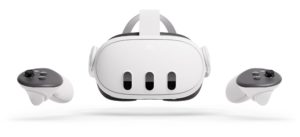Virtual Reality Gaming – Quest 3 and Quest 2
 The world of VR (virtual reality) headsets continues to evolve. While the pricey Apple Vision Pro was just released, last fall saw the release of the Quest 3. The Quest 3 is around 6x cheaper, and more importantly for this site and article, is far more focused on entertainment than business/work. I jumped on the VR bandwagon with the first PlayStation (PSVR) but sat out the next generation (PSVR2 and Quest 2) but with the release of the Quest 3 I thought I’d test the waters again. The primary reason was to be able to play multiplayer games with friends that also owned Quest headsets. After a few months of play, it seems like a good time to share my thoughts on the system in general and some of the newest games. Today, we’ll look at the headset and mention a few games. In the coming weeks we’ll evaluate some of the games in more detail.
The world of VR (virtual reality) headsets continues to evolve. While the pricey Apple Vision Pro was just released, last fall saw the release of the Quest 3. The Quest 3 is around 6x cheaper, and more importantly for this site and article, is far more focused on entertainment than business/work. I jumped on the VR bandwagon with the first PlayStation (PSVR) but sat out the next generation (PSVR2 and Quest 2) but with the release of the Quest 3 I thought I’d test the waters again. The primary reason was to be able to play multiplayer games with friends that also owned Quest headsets. After a few months of play, it seems like a good time to share my thoughts on the system in general and some of the newest games. Today, we’ll look at the headset and mention a few games. In the coming weeks we’ll evaluate some of the games in more detail.
First, let’s talk about the entire Quest line. Starting with “2”, the Quest series of headsets introduced an all-in-one approach. Games and other apps are run onboard the headset, so no wires are needed to connect to a PC. This is a big deal. Additionally, neither Quest headset needs additional cameras to be set up. The freedom to play anywhere in the house is huge. Moving to a new location is as simple as letting the headset figure out the floor and drawing out an outline to tell the headset the location of any blocking objects. The Quest 3 even eliminates the need to draw out a floor – it will figure out blocking objects automatically. Both Quests can also connect to a PC as sort of a VR monitor, where the PC does the computations and the headset is the display. This allows gamers to play any VR games they already own on their computer (via Steam or what have you.) Recently, Meta made significant upgrades to the software so now the headsets can reliably connect wirelessly to a computer. It is most reliable if the computer and headset are not both using wifi bandwidth, so it is recommended to have the PC directly connected to the network.
While both Quest models currently run all the same games, there are still a few differences. One would hope any changes are all for the better.
- First, the Quest 3 is a faster computer, capable of running fancier graphics at higher frame rates. Many games do not yet take advantage of this, but a few do switch to fancier graphics when run on a Quest 3. Going forward there may be titles that only run on a Quest 3, but with the large installed base of Quest 2’s I would hazard a guess that they will be rare.
- Second, the most obvious change is to the external cameras. The Quest 2 can display a grainy, black and white image of one’s surroundings while wearing the headset, but the new Quest 3 has a much improved colored display. When paired with the faster processor, the Quest 3 can run mixed-reality games where the game played on the headset displays, and uses, a player’s surroundings as part of the game. The excellent demo included with the headset has little furballs banging on the walls of the room, eventually breaking through and one must shoot them to collect them in the time allotted.
- The external cameras are also put to use to track a player’s hands. When a player isn’t holding controllers, the headset can interpret gestures (like pointing or pinching one’s fingers) as commands. One of the nicest features is the ability to “grab” a display, move it around, and poke at buttons on it with your fingers.
- Finally, the new headset is smaller and lighter due to a different style of lens on the eyepiece. These lenses are thinner and thus the headset overall is lighter. I think the Quest 3 is supposed to have a longer lasting battery, but I have not found that to be the case. The Quest 3 can sometimes be a bigger power hog and so I’ve found its battery power to last a comparable amount of time to a Quest 2, perhaps a bit less.
- The big disadvantage of the Quest 3 is simply price. Currently, Quest 2’s are on sale around $250 for the cheapest model. The least expensive Quest 3 is around twice that (although it does have more storage.) That’s a big difference. The Quest 2 was so inexpensive that we purchased some for our boys to use so that we can all play in the virtual worlds together.
As mentioned, the Quest 3 can run the entire library of the Quest 2 so there’s quite a few titles for a new owner to investigate. I thought I’d list some of the classics here, in an effort to help any other new-to-VR folks out there. You have probably heard of at least some of these in passing, and I’ll try to return to this list in the future for more detailed coverage. (NOTE: I’m putting a “link code” after each of these games. If you get one using the code, it will get you a 25% discount if it’s not already on sale. I’ll then also get a $5 kickback or some such thing… use it if helps you, otherwise ignore the codes…)

Beat Saber – If you know of any VR game in the past 6 or 7 years, you’ve heard of Beat Saber. Armed with two glowing sword blades, you must slash through oncoming blocks to the beat of the (often techno or hard rock) music. There are various levels for each song ranging from simplistic for even a beginner to expert+ which requires even good players to try out in practice mode first. Its popularity is well deserved, as the VR experience paired with music and slashing can really help one “get into” the game. (Referral Link)

Synth Riders – Another take on the hit-the-boxes-to-the-music genre, Scythe Riders has oncoming spheres to punch with your hands, but what really stands out are the frequently used rails. Rails require a player to keep their hands on the rail while the rail journeys up,down, and over. Because of the need to put one’s hands in a location and move them smoothly around to the music, I think Synth Riders feels much more like a dance than Beat Saber. Another nice feature is the ability to download song/level challenges that other players have made using a freely available tool. (Referral Link)
Pistol Whip – I have not played Pistol Whip but it is a more recent game that tries to tie music in with shooting down enemies with pistols (surprise), etc…

Walk About Mini-Golf – I cannot recommend this enough as a casual game with friends. You can stand around and chat with each other (your avatar “head” is displayed as well as your hands, with the mouth voice-activated so it looks like your friends are talking and gesturing) as you play through courses. There are several included in the game but dozens more you can purchase, with more recent ones becoming more elaborate. (There’s one set in a supervillain lair, another in the Labyrinth movie, and one crazy bonkers one that reminded me of a day-of-the-dead style color scheme combined with crazy ball effects.) I highly recommend the game for casual multiplayer hangouts. (Referral Link)

Dungeons of Eternity – This is a simple first person dungeon exploration where you run around through rooms hacking/slashing/throwing/shooting your way through mobs that come at you. There’s not a lot of depth here but what is there is well executed. Great with friends (only up to 3 players total, though) for some casual cooperative fighting. While players gain “levels” actual improvement revolves around finding better gear in chests scattered through the dungeons. I believe the point is that higher level players can find higher level items. (Referral Link)

Demeo – On the other spectrum of cooperative dungeon crawling, Demo is like a miniatures dungeon crawl boardgame on your tabletop. (I think the Quest 3 even tries to use it augmented reality to make it look like the dungeon is actually on your table.) Here, players loom over a small dungeon and reach down to move their little character around as they explore and fight using cards and dice rolls. It’s often been compared to a sort of 3D Dungeons and Dragons miniatures game. (Referral Link)

SuperHot – Another famous game, here you are trying to defeat multiple enemies all at the same time but there’s a huge catch. Nothing moves unless you move. This means you can move slowly and time moves slowly. Soon, players are doing a Matrix-like maneuver to dodge bullets while disarming a nearby enemy, grabbing their gun to shoot down several others who are running up from behind. There’s a somewhat short campaign to play but then many different modes to unlock from there.

Moss & Moss 2 – Another popular VR genre is puzzle games. Moss (& Moss 2) has players looking after a little mouse, Moss, as he goes off on an adventure. You control Moss, but also can lean in and affect his little world, adjusting the environment as needed. It’s 3D of course, so there are secrets and other things to find that can only be discovered by moving your head/body around to see over and around objects. (Referral Link – Moss 2)

A Fisherman’s Tale – This VR puzzle game gets really meta. You play as a little man in a lighthouse that has his own replica of a lighthouse on the table in the center of the room. However, that little lighthouse is also YOUR lighthouse. If you reach into the little lighthouse a (your) giant hand reaches into the lighthouse in which you’re standing. It turns out there’s an even bigger lighthouse outside your lighthouse… The puzzles take advantage of the fact that you can move and find things in one lighthouse that can be moved or changed in the other lighthouses. I’ve not finished the game yet, but have enjoyed what I’ve done so far (maybe ½ way complete?)
Verdict:
The Quest 3 is a great introduction to VR and if your budget allows it, I think the improvements are worth it. As more mixed-reality games come out, the difference between the two headsets will continue to grow. However, the Quest 2 gives almost the same experience but at almost half the cost. For a family of several people, buying 2 Quest 2’s and playing together might be the better choice. Virtual Reality isn’t for everyone but for those who’ve been waiting to give it a try, it’s a great time to try it out.
Kid Factor:
Every game varies in intensity, nearly all games on this list are pretty kid-friendly. The main issue is screen time and the use of the goggles. They are adjustable but there are limits to how small they go and I’d be a bit uncomfortable going too young for any long period of time. Late elementary at least but still with limits. Remember that the sound is built in to the headset so a parent would need to keep their ear out for the volume setting to make sure it doesn’t get too high.





Discussion Area - Leave a Comment